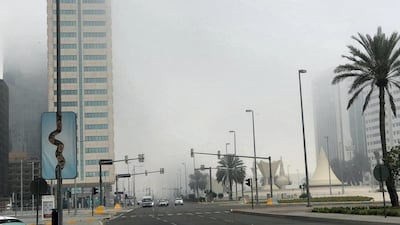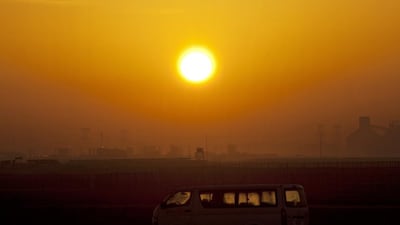Temperatures could hit a scorching 49C in the UAE on Sunday, with forecasters warning the intense heat is here until Monday at the earliest.
It comes after parts of the UAE were seared by a sizzling 49.9C over the weekend.
Mezaira in the southwest and Sweihan, which is close to Al Ain, were among the places that endured the worst of the heat, forecasters said on Sunday.
The conditions are chiefly caused by southwest winds, carrying dry heat from the desert sands of southern Arabia across to the UAE.
“The temperature has been increasing in the UAE - particularly in the interior of the country - over the past few days,” a forecaster from the NCM said.
“This is a very hot wind and it will last until Monday night.”
The weather has already had tragic consequences in Dubai. A six-year-old boy died after being left on a bus on Saturday and medics were unable to save him.
Compounding the high temperatures is a spike in humidity which has suffocated coastal areas. Humidity - essentially the amount of water vapour in the air - reached a stifling 100 per cent in some parts on Sunday morning.
This means the air is effectively no longer able to absorb moisture - including even human sweat - disrupting the body’s cooling process.
The humidity is being caused by the warming of the seas, which increases evaporation, while hotter temperatures on the land means the air absorbs even more water.
The good news, however, is that UAE residents can expect some brief respite from the heat on Tuesday. North-westerly winds will usher in weather that is at least three to four degrees cooler. Gusts of up to 45kph are set to kick up dust clouds and churn the seas.
“Visibility will also become poor,” the forecaster said. “Especially over exposed areas.”
Across the country, preparations for the summer season are well underway. The midday break for workers came into force on June 15.
The UAE-wide rule ensures labourers who work outside rest from 12.30pm to 3pm every day until September 15.
Public schools, meanwhile, have already announced reduced hours until the term ends in July. Authorities have also urged people to stay indoors, where possible, during the hottest part of the day and stay hydrated.
The dry heat is affecting countries across the region. Iraq’s notoriously brutal summers have also arrived early and average daily temperatures this June stand at 48C - up from about 40C in previous years.
Only two months ago, talk of the UAE's so-called bad weather - including rain and thunder - dominated conversations up and down the country.
One of the more unseasonal UAE winters of late featured rain, clouds, dust and lightning. Yet countless conversations in offices, social media and at home wondered when the bad weather would end. Now many are no doubt hoping for the heat to ease.
The President's Cake
Director: Hasan Hadi
Starring: Baneen Ahmad Nayyef, Waheed Thabet Khreibat, Sajad Mohamad Qasem
Rating: 4/5
FORSPOKEN
%3Cp%3EDeveloper%3A%20Luminous%20Productions%0D%3Cbr%3EPublisher%3A%20Square%20Enix%0D%3Cbr%3EConsole%3A%20PC%2C%20PS5%0D%3Cbr%3ERelease%20date%3A%20January%3C%2Fp%3E%0A
Company%20of%20Heroes%203
%3Cp%3EDeveloper%3A%20Relic%20Entertainment%3Cbr%3EPublisher%3A%20SEGA%3Cbr%3EConsole%3A%20PC%2C%20PS5%2C%20XSX%3Cbr%3ERelease%20date%3A%20February%3C%2Fp%3E%0A
Star%20Wars%20Jedi%3A%20Survivor
%3Cp%3EDeveloper%3A%20Respawn%20Entertainment%0D%3Cbr%3EPublisher%3A%20Electronic%20Arts%0D%3Cbr%3EConsole%3A%20PC%2C%20PS5%2C%20XSX%0D%3Cbr%3ERelease%20date%3A%20March%3C%2Fp%3E%0A
Suicide%20Squad%3A%20Kill%20the%20Justice%20League
%3Cp%3EDeveloper%3A%20Rocksteady%20Studios%0D%3Cbr%3EPublisher%3A%20Warner%20Bros%0D%3Cbr%3EConsole%3A%20PC%2C%20PS5%2C%20XSX%0D%3Cbr%3ERelease%20date%3A%20May%3C%2Fp%3E%0A
Final%20Fantasy%20XVI
%3Cp%3EDeveloper%3A%20Square%20Enix%0D%3Cbr%3EPublisher%3A%20Square%20Enix%0D%3Cbr%3EConsole%3A%20PS5%0D%3Cbr%3ERelease%20date%3A%20June%3C%2Fp%3E%0A
Street%20Fighter%206
%3Cp%3EDeveloper%3A%20Capcom%0D%3Cbr%3EPublisher%3A%20Capcom%0D%3Cbr%3EConsole%3A%20PS5%2C%20XSX%2C%20PC%0D%3Cbr%3ERelease%20date%3A%20June%3C%2Fp%3E%0A
Diablo%20IV
%3Cp%3EDeveloper%3A%20Blizzard%20Entertainment%0D%3Cbr%3EPublisher%3A%20Blizzard%20Entertainment%0D%3Cbr%3EConsole%3A%20PC%2C%20PS5%2C%20XSX%0D%3Cbr%3ERelease%20date%3A%20June%3C%2Fp%3E%0A
Baldur's%20Gate%203
%3Cp%3EDeveloper%3A%20Larian%20Studios%0D%3Cbr%3EPublisher%3A%20Larian%20Studios%0D%3Cbr%3EConsole%3A%20PC%0D%3Cbr%3ERelease%20date%3A%20August%3C%2Fp%3E%0A
The%20Legend%20of%20Zelda%3A%20Tears%20of%20The%20Kingdom
%3Cp%3EDeveloper%3A%20Nintendo%0D%3Cbr%3EPublisher%3A%20Nintendo%0D%3Cbr%3EConsole%3A%20Nintendo%20Switch%0D%3Cbr%3ERelease%20date%3A%20September%3C%2Fp%3E%0A
Marvel's%20Spider-Man%202
%3Cp%3EDeveloper%3A%20Insomniac%20Games%0D%3Cbr%3EPublisher%3A%20PlayStation%0D%3Cbr%3EConsole%3A%20PS5%0D%3Cbr%3ERelease%20date%3A%20Fall%3C%2Fp%3E%0A
Assassin's%20Creed%20Mirage
%3Cp%3EDeveloper%3A%20Ubisoft%0D%3Cbr%3EPublisher%3A%20Ubisoft%0D%3Cbr%3EConsole%3A%20PC%2C%20PS5%2C%20XSX%2C%20Amazon%20Luna%0D%3Cbr%3ERelease%20date%3A%202023%3C%2Fp%3E%0A
Starfield
%3Cp%3EDeveloper%3A%20Bethesda%20Game%20Studios%0D%3Cbr%3EPublisher%3A%20Bethesda%20Softworks%0D%3Cbr%3EConsole%3A%20PC%2C%20Xbox%0D%3Cbr%3ERelease%20date%3A%202023%3C%2Fp%3E%0A
Our legal consultants
Name: Hassan Mohsen Elhais
Position: legal consultant with Al Rowaad Advocates and Legal Consultants.
ULTRA PROCESSED FOODS
- Carbonated drinks, sweet or savoury packaged snacks, confectionery, mass-produced packaged breads and buns
- margarines and spreads; cookies, biscuits, pastries, cakes, and cake mixes, breakfast cereals, cereal and energy bars;
- energy drinks, milk drinks, fruit yoghurts and fruit drinks, cocoa drinks, meat and chicken extracts and instant sauces
- infant formulas and follow-on milks, health and slimming products such as powdered or fortified meal and dish substitutes,
- many ready-to-heat products including pre-prepared pies and pasta and pizza dishes, poultry and fish nuggets and sticks, sausages, burgers, hot dogs, and other reconstituted meat products, powdered and packaged instant soups, noodles and desserts.
THE SPECS
Jaguar F-Pace SVR
Engine: 5-litre supercharged V8
Transmission: 8-speed automatic
Power: 542bhp
Torque: 680Nm
Price: Dh465,071
Sly%20Cooper%20and%20the%20Thievius%20Raccoonus
%3Cp%3E%3Cstrong%3EDeveloper%3A%3C%2Fstrong%3E%20Sucker%20Punch%20Productions%3Cbr%3E%3Cstrong%3EPublisher%3A%3C%2Fstrong%3E%20Sony%20Computer%20Entertainment%3Cbr%3E%3Cstrong%3EConsole%3A%3C%2Fstrong%3E%20PlayStation%202%20to%205%3Cbr%3E%3Cstrong%3ERating%3A%3C%2Fstrong%3E%205%2F5%3C%2Fp%3E%0A
UAE%20ILT20
%3Cp%3E%3Cstrong%3EMarquee%20players%3A%3C%2Fstrong%3E%3Cbr%3EMoeen%20Ali%2C%20Andre%20Russell%2C%20Dawid%20Malan%2C%20Wanindu%20Hasiranga%2C%20Sunil%20Narine%2C%20Evin%20Lewis%2C%20Colin%20Munro%2C%20Fabien%20Allen%2C%20Sam%20Billings%2C%20Tom%20Curran%2C%20Alex%20Hales%2C%20Dushmantha%20Chameera%2C%20Shimron%20Hetmyer%2C%20Akeal%20Hosein%2C%20Chris%20Jordan%2C%20Tom%20Banton%2C%20Sandeep%20Lamichhane%2C%20Chris%20Lynn%2C%20Rovman%20Powell%2C%20Bhanuka%20Rajapaksa%2C%20Mujeeb%20Ul%20Rahman%3C%2Fp%3E%0A%3Cp%3E%3Cstrong%3EInternational%20players%3A%3C%2Fstrong%3E%3C%2Fp%3E%0A%3Cp%3ELahiru%20Kumara%2C%20Seekugge%20Prassanna%2C%20Charith%20Asalanka%2C%20Colin%20Ingram%2C%20Paul%20Stirling%2C%20Kennar%20Lewis%2C%20Ali%20Khan%2C%20Brandon%20Glover%2C%20Ravi%20Rampaul%2C%20Raymon%20Reifer%2C%20Isuru%20Udana%2C%20Blessing%20Muzarabani%2C%20Niroshan%20Dickwella%2C%20Hazaratullah%20Zazai%2C%20Frederick%20Klassen%2C%20Sikandar%20Raja%2C%20George%20Munsey%2C%20Dan%20Lawrence%2C%20Dominic%20Drakes%2C%20Jamie%20Overton%2C%20Liam%20Dawson%2C%20David%20Wiese%2C%20Qais%20Ahmed%2C%20Richard%20Gleeson%2C%20James%20Vince%2C%20Noor%20Ahmed%2C%20Rahmanullah%20Gurbaz%2C%20Navin%20Ul%20Haq%2C%20Sherfane%20Rutherford%2C%20Saqib%20Mahmood%2C%20Ben%20Duckett%2C%20Benny%20Howell%2C%20Ruben%20Trumpelman%3C%2Fp%3E%0A
PREMIER LEAGUE STATS
Romelu Lukaku's goalscoring statistics in the Premier League
Season/club/appearances (substitute)/goals
2011/12 Chelsea: 8(7) - 0
2012/13 West Brom (loan): 35(15) - 17
2013/14 Chelsea: 2(2) - 0
2013/14 Everton (loan): 31(2) - 15
2014/15 Everton: 36(4) - 10
2015/16 Everton: 37(1) - 18
2016/17 Everton: 37(1) - 25
What%20is%20Dungeons%20%26%20Dragons%3F%20
%3Cp%3EDungeons%20%26amp%3B%20Dragons%20began%20as%20an%20interactive%20game%20which%20would%20be%20set%20up%20on%20a%20table%20in%201974.%20One%20player%20takes%20on%20the%20role%20of%20dungeon%20master%2C%20who%20directs%20the%20game%2C%20while%20the%20other%20players%20each%20portray%20a%20character%2C%20determining%20its%20species%2C%20occupation%20and%20moral%20and%20ethical%20outlook.%20They%20can%20choose%20the%20character%E2%80%99s%20abilities%2C%20such%20as%20strength%2C%20constitution%2C%20dexterity%2C%20intelligence%2C%20wisdom%20and%20charisma.%20In%20layman%E2%80%99s%20terms%2C%20the%20winner%20is%20the%20one%20who%20amasses%20the%20highest%20score.%3C%2Fp%3E%0A
Ballon d’Or shortlists
Men
Sadio Mane (Senegal/Liverpool), Sergio Aguero (Aregentina/Manchester City), Frenkie de Jong (Netherlans/Barcelona), Hugo Lloris (France/Tottenham), Dusan Tadic (Serbia/Ajax), Kylian Mbappe (France/PSG), Trent Alexander-Arnold (England/Liverpool), Donny van de Beek (Netherlands/Ajax), Pierre-Emerick Aubameyang (Gabon/Arsenal), Marc-Andre ter Stegen (Germany/Barcelona), Cristiano Ronaldo (Portugal/Juventus), Alisson (Brazil/Liverpool), Matthijs de Ligt (Netherlands/Juventus), Karim Benzema (France/Real Madrid), Georginio Wijnaldum (Netherlands/Liverpool), Virgil van Dijk (Netherlands/Liverpool), Bernardo Silva (Portugal/Manchester City), Son Heung-min (South Korea/Tottenham), Robert Lewandowski (Poland/Bayern Munich), Roberto Firmino (Brazil/Liverpool), Lionel Messi (Argentina/Barcelona), Riyad Mahrez (Algeria/Manchester City), Kevin De Bruyne (Belgium/Manchester City), Kalidou Koulibaly (Senegal/Napoli), Antoine Griezmann (France/Barcelona), Mohamed Salah (Egypt/Liverpool), Eden Hazard (BEL/Real Madrid), Marquinhos (Brazil/Paris-SG), Raheem Sterling (Eengland/Manchester City), Joao Félix(Portugal/Atletico Madrid)
Women
Sam Kerr (Austria/Chelsea), Ellen White (England/Manchester City), Nilla Fischer (Sweden/Linkopings), Amandine Henry (France/Lyon), Lucy Bronze(England/Lyon), Alex Morgan (USA/Orlando Pride), Vivianne Miedema (Netherlands/Arsenal), Dzsenifer Marozsan (Germany/Lyon), Pernille Harder (Denmark/Wolfsburg), Sarah Bouhaddi (France/Lyon), Megan Rapinoe (USA/Reign FC), Lieke Martens (Netherlands/Barcelona), Sari van Veenendal (Netherlands/Atletico Madrid), Wendie Renard (France/Lyon), Rose Lavelle(USA/Washington Spirit), Marta (Brazil/Orlando Pride), Ada Hegerberg (Norway/Lyon), Kosovare Asllani (Sweden/CD Tacon), Sofia Jakobsson (Sweden/CD Tacon), Tobin Heath (USA/Portland Thorns)
'Lost in Space'
Creators: Matt Sazama, Burk Sharpless, Irwin Allen
Stars: Molly Parker, Toby Stephens, Maxwell Jenkins
Rating: 4/5
RESULT
Kolkata Knight Riders 169-7 (20 ovs)
Rajasthan Royals 144-4 (20 ovs)
Kolkata win by 25 runs
Next match
Sunrisers Hyderabad v Kolkata Knight Riders, Friday, 5.30pm
How to help
Call the hotline on 0502955999 or send "thenational" to the following numbers:
2289 - Dh10
2252 - Dh50
6025 - Dh20
6027 - Dh100
6026 - Dh200
What is graphene?
Graphene is extracted from graphite and is made up of pure carbon.
It is 200 times more resistant than steel and five times lighter than aluminum.
It conducts electricity better than any other material at room temperature.
It is thought that graphene could boost the useful life of batteries by 10 per cent.
Graphene can also detect cancer cells in the early stages of the disease.
The material was first discovered when Andre Geim and Konstantin Novoselov were 'playing' with graphite at the University of Manchester in 2004.
Squad
Ali Kasheif, Salim Rashid, Khalifa Al Hammadi, Khalfan Mubarak, Ali Mabkhout, Omar Abdulrahman, Mohammed Al Attas, Abdullah Ramadan, Zayed Al Ameri (Al Jazira), Mohammed Al Shamsi, Hamdan Al Kamali, Mohammed Barghash, Khalil Al Hammadi (Al Wahda), Khalid Essa, Mohammed Shaker, Ahmed Barman, Bandar Al Ahbabi (Al Ain), Al Hassan Saleh, Majid Suroor (Sharjah) Walid Abbas, Ahmed Khalil (Shabab Al Ahli), Tariq Ahmed, Jasim Yaqoub (Al Nasr), Ali Saleh, Ali Salmeen (Al Wasl), Hassan Al Muharami (Baniyas)
The specs
Engine: 1.5-litre turbo
Power: 181hp
Torque: 230Nm
Transmission: 6-speed automatic
Starting price: Dh79,000
On sale: Now
MORE ON TURKEY'S SYRIA OFFENCE
UAE tour of Zimbabwe
All matches in Bulawayo
Friday, Sept 26 – UAE won by 36 runs
Sunday, Sept 28 – Second ODI
Tuesday, Sept 30 – Third ODI
Thursday, Oct 2 – Fourth ODI
Sunday, Oct 5 – First T20I
Monday, Oct 6 – Second T20I
The%20specs
%3Cp%3E%3Cstrong%3EPowertrain%3A%20%3C%2Fstrong%3ESingle%20electric%20motor%0D%3Cbr%3E%3Cstrong%3EPower%3A%20%3C%2Fstrong%3E201hp%0D%3Cbr%3E%3Cstrong%3ETorque%3A%20%3C%2Fstrong%3E310Nm%0D%3Cbr%3E%3Cstrong%3ETransmission%3A%20%3C%2Fstrong%3ESingle-speed%20auto%0D%3Cbr%3E%3Cstrong%3EBattery%3A%20%3C%2Fstrong%3E53kWh%20lithium-ion%20battery%20pack%20(GS%20base%20model)%3B%2070kWh%20battery%20pack%20(GF)%0D%3Cbr%3E%3Cstrong%3ETouring%20range%3A%20%3C%2Fstrong%3E350km%20(GS)%3B%20480km%20(GF)%0D%3Cbr%3E%3Cstrong%3EPrice%3A%20%3C%2Fstrong%3EFrom%20Dh129%2C900%20(GS)%3B%20Dh149%2C000%20(GF)%0D%3Cbr%3E%3Cstrong%3EOn%20sale%3A%3C%2Fstrong%3E%20Now%3C%2Fp%3E%0A
PREMIER LEAGUE FIXTURES
Saturday (UAE kick-off times)
Watford v Leicester City (3.30pm)
Brighton v Arsenal (6pm)
West Ham v Wolves (8.30pm)
Bournemouth v Crystal Palace (10.45pm)
Sunday
Newcastle United v Sheffield United (5pm)
Aston Villa v Chelsea (7.15pm)
Everton v Liverpool (10pm)
Monday
Manchester City v Burnley (11pm)
UAE currency: the story behind the money in your pockets









